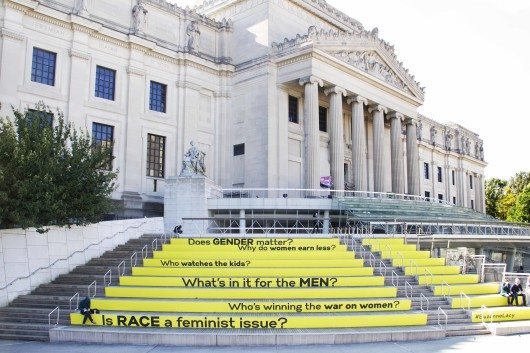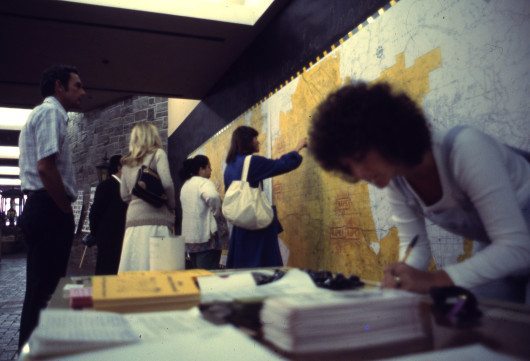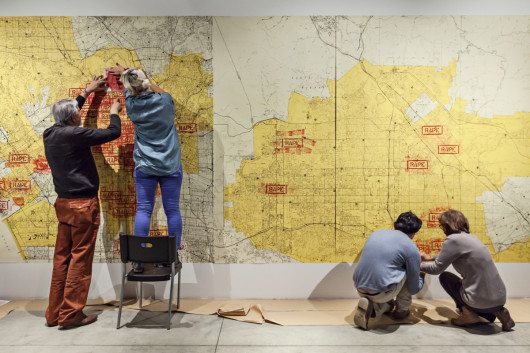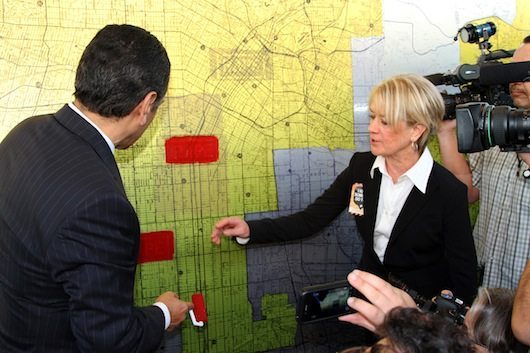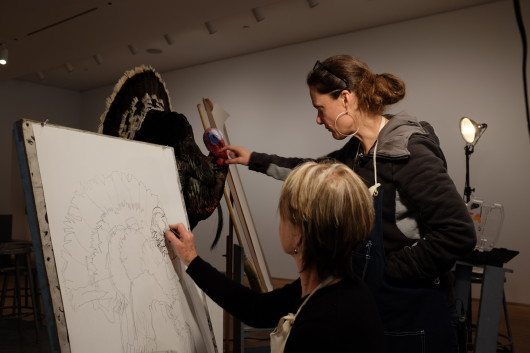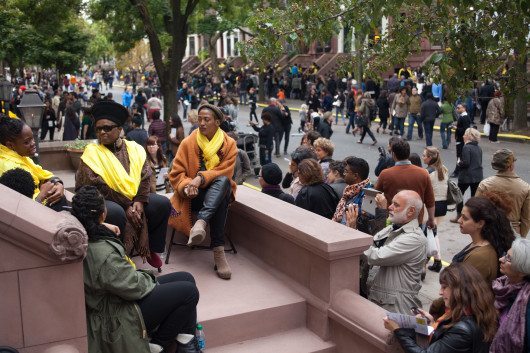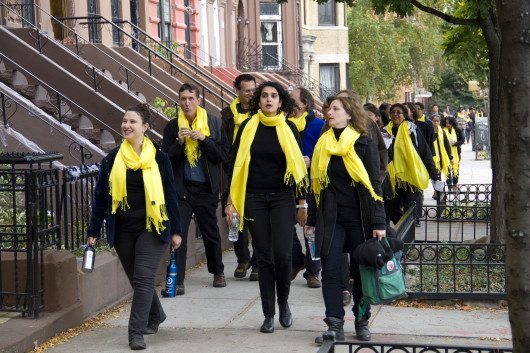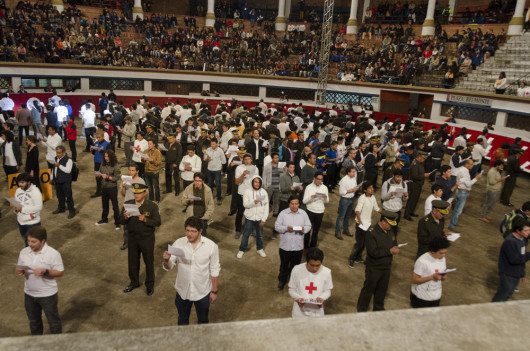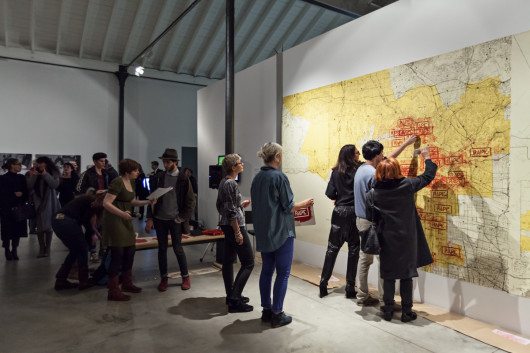Editor’s Introduction
WEAD is proud to honor SUZANNE LACY as 2016 Feature Artist. For 40+ years she has produced ground-breaking community-based social justice, feminist artwork. More than a performance artist, she orchestrates large crowds of participants in colorful public tableaux rooted in local knowledge that critique global political issues. For inspiring us to dig deeper and aim higher, we salute her.
FEMINIST ART FROM THE 1970s, like art inspired by Marxism and other political movements (including early environmentalism), developed proximate to other art movements such as conceptual and performance art. However, historification of feminist art leaves out many key concepts from the work of that era. These artists were not merely about form, but about forms of perception and production. For instance, one of my early works, Three Weeks In May (1977), is normally represented by its subject matter—exploring the taboo topic of rape—but I would argue that its real contribution to the arts (as opposed to politics) is as a predecessor of social practice and as an early example of media analysis and intervention, in a time when artists from Doug Davis to Ant Farm were exploring art’s potential relationship to video and popular culture.
Particularly in California, feminist artists were experimentally engaged in the public sphere, but like feminism in general, they are often identified with politics, to the exclusion of other concerns, and cast in roles that belie the complexities of identities and influences. If you think, for example in the case of my work, that body performance and conceptual photography were only about gender, you will miss other connections—such as the physical fact of the body and its impact on consciousness (the relationship between organ transplants and identity, for instance)—and the relationship of body experience to semiotics (psychological states expressed through physical metaphor).
Today, my work investigates sociopolitical issues by creating platforms for public voice and strengthening networks among community organizations. Projects addressing violence against women (clearly a feminist activist project) would probably be seen exclusively against a backdrop of what today has become social practice. When I was commissioned to produce Three Weeks In January (2012) for The Getty’s Pacific Standard Time Performance Festival, I was motivated to re-create parts of Three Weeks in May to reaffirm the links among feminism, activism and social practice in art. While the issue of rape addressed in the new piece was similar to that of the 1977 piece, the positioning of the artist within the work had changed, which in turn affected its conceptual underpinnings.
In 1977, when I made Three Weeks In May with Leslie Labowitz and a team of artists from The Woman’s Building in Los Angeles, it was urgent to bring the topic of violence against women into public discussion and expose how many women had been affected. Our collective art actions created networks of support for women that previously had been disparate at best, or just plain non-existent. And our media interventions demanded political action by police and city governments. At that time we artists were positioned in fact as activists exposing issues.
By 2012, a public disclosure of rape was no longer the work’s raison d’être. For decades, violence against women had been a critical focus of community activists, there were numerous local and global support groups for us to work with, and the police department was active in rape prevention across Los Angeles. Three Weeks In January thus became a formal interrogation of the ways in which violence against women had been systematically embedded in language, aesthetics, institutions and intercultural organizing. It focused on where Los Angeles is now, forty years into the anti-rape movement, and included new organizing strategies such as social media.
Looking back over these projects, and the work of early feminist artists, reveals old shibboleths of Second Wave feminism that can alienate young activists working today. Prominent current critiques of feminism include concerns about the exclusion of Black, Latina and Transwomen; and a lack of recognition of class differences such as the differences between women at the top of corporate ladders and those struggling through multiple jobs; a U.S.-centric movement that overlooks global differences; and an exclusionary stance towards men. New strategies—such as cross-generational dialogues, intersectionality, a global awareness and cultural sensitivity, and a broader vocabulary for self-definition around gender—create more inclusive coalitions open to men, women and everyone in between. Some of these critiques of early feminism are accurate, reflecting broader cultural changes in our awareness now. Some are a product of historical distortions of the work of feminist activists and the breadth of their concerns. There were, of course, Second Wave feminists doing more cross-ethnic and cultural organizing than is remembered. It is important for equity movements to air critiques and misconceptions, and engage in honest debate, if only to determine where the potential for mutual support and collaboration lies.
Last year, Andrea Bowers and I created Drawing Lessons (2014), a nine-day performance at The Drawing Center in New York City wherein we used Andrea’s attempt to teach me to draw as a platform for larger discussions about feminism today. While Andrea and I both address feminist and class issues in our individual practices, our formal outputs are very different. This project offered ways to explore the relationship between our generations.
Our installation in The Drawing Center was an imitation of classic drawing and painting studios: lights, platform, props, blackboards and drawing easels. In the next room our camping gear and clothes were on display, and at night we slept in individual tents for the duration of the work. During the day our work was open to the public, who participated as models, instructors or contributors to periodic informal conversations generally in front of an incidental audience.
The idea that I might actually learn to draw over the course of nine days was a bit absurd, but the generational reversal was metaphoric for many questions about the relationship between Second and Third Wave feminist artists. Throughout, our conversations moved between personal, political, pedagogical and aesthetic ideas. One of the things I learned during the week, besides contour drawing, was the ways in which young women artists coming of age subsequent to the mid-1980s often felt judged by 1970s feminists. It seemed that many women of Andrea’s generation often felt that my generation ‘disapproved’ of them.
Indeed, there were mistakes in the transmission of feminist art ideas by what I might call the ‘first’ generation feminist artists. Some of my colleagues seemed more committed to ideological purity than to making bridges between generations. In order to make political alliances, you have to be committed to accommodating difference. Some 1970s-era feminist artists seemed to adopt the ‘We’ve already been there’ position. And while their frustration with a new generation’s political ideas is understandable, I think such judgments are counterproductive in the long haul.
The artists and organizers that I invited to be a part of Drawing Lessons came from the feminist art movement of the 1970s, in a moment when art was extremely experimental and when bodies were a prominent materiality. In a sense, we didn’t have a lot to lose, particularly those of us on the West Coast outside of prominent arts institutions. Women I asked to join us (for the most part familiar with performance or guerilla art) tended to laugh as they agreed to perform with us. The artists in Andrea’s generation, informed by theoretical rigor perhaps, were more questioning and, in some cases, circumspect about engaging.
In the 1970s, feminist organizations were mostly made up of women. We saw our work to dismantle patriarchy as something necessarily done only by women. A desire for inclusivity, social impact and agency has created forms of organizing that are no longer gender-specific. Today, I’m often invited by men to make work on issues around gender equality. The production of these works includes women, men, Trans men and women, and more.
During the development of Between the Door and the Street (2013), Creative Time’s Chief Curator Nato Thompson, project manager Jean Cooney and I decided to explore the contemporary state of ‘feminist’ and ‘activist’ work, and how people were currently thinking about these issues. We began by researching prominent women working in anti-racism, poverty, workers’ rights, immigration and violence—women who were articulate spokespersons about the current state of things. Jean and I created an advisory board of 20 busy, important and impressive women (and one man) who each contributed to the design and production of the performance. They identified key issues and over 100 organizations—the first platform for organizing.
This is pretty much classic community organizing, where leadership is identified to frame the ideas and to direct action. Of course the difficulty in the greater New York region is how to define ‘community,’ which, in terms of gender justice is vast. But that was part of the research—to determine new concepts linking activism and feminism, identifying contested fault lines, and querying where intersections might be productive.
Artist and producer Jennifer Hsu was hired by Creative Time to organize the extensive participation needed to fill up an entire city block of stoops. We analyzed the region’s demographics and created a set of standards by which to measure the effectiveness of our inclusion tactics. The ‘Gang of 8,’ a group of young women Creative Time hired to organize participants, continued throughout our process to ensure that transgendered, disabled and ex-incarcerated people, among others, were represented. Hsu trained these young women in community organizing and worked with them to contact organizations, develop participant groups and, on the day of the performance, become key stage people. Our ‘strategy’ was to seek possible convergences and common areas of concern, and strengthen recognition of the value of one another’s work. In particular we wanted to support the work of younger activists. It was a metaphoric ‘coalition,’ meant to bring attention to a broadened definition of feminism.
The work of 1970s feminist artists has had a profound effect on the art world, including, quite visibly, the developments in social practice, collaboration, questions of authorship and expanded audience explorations. Feminists were significant in developing interdisciplinary collaborations, cross-platforms, public address, media interventions, institutional critique, process and performance art. I don’t privilege art over other forms of activism, such as public speech, voter campaigns and protests, but I do prefer to communicate through art. I believe art is a method for pushing the feminist movement beyond the borders of the movement itself and into its surrounding public spheres. I have witnessed the shifts in consciousness that happens when large coalitions of individual participants, community organizations, governments and art institutions come together under the auspices of a performance or other expressive actions. And in the process, I have experienced my own shifts in consciousness, listening and learning new strategies from my collaborators, watching the world change around us, seeing women progress, bemoaning our continued struggles through violence and inequality, and then doing more work.
SAMPLE PROJECTS 2010-2015
De tu Puño y Letra (2015). On November 25, the International Day for the Elimination of Violence Against Women, I produced a performance in Quito, Ecuador, entitled De tu puño y letra, diálogos en el ruedo. This work is the result of a year and a half of intensive planning and a collaboration involving at least 1,000 people who participated in workshops, production, performance and artistic composition. Their work was essential to the success of this profoundly participatory project, one that I hope will continue to resonate with the City of Quito’s work on culture and equity. The project was only possible within the unique community I found in Quito: people working on eliminating violence, such as the Cartas de Mujeres project; cultural producers eager to demonstrate the role of art in community transformation; researchers such as those from the Instituto de la Ciudad and academics from UDLA and USFQ and others; and artists of many disciplines who participated in our project, including those from film, music, visual arts, and theater.
Three Weeks In May Recreation (2014). As part of Suzanne Lacy: Gender Agendas, an exhibition at Centro per l’Arte Contemporanea Luigi Pecci in Milan, curated by Fabio Cavallucci and Megan Steinman, I created a partial reenactment of Three Weeks in May (1977), which originally had been presented as a three-week series of private conversations and public performances on the topic of rape in Los Angeles, California.
A central component of the original work was a large map of LA, installed near City Hall, on which I marked the rape reports that I collected daily from the police department.The Milan re-enactment took place over three days, during which Italian feminists, art students from the Nuova Accademia di Belle Arti Milano and museum guests used the original 1977 police reports to mark a new map, while reading each report out loud over a speaker. The variety of volunteers—young, old, male, female, introverts and extroverts alike—was striking, with both young men and women engaged in expressing their ideas for action.
Tattooed Skeleton (2010). This coalition project on domestic violence in Spain was a collaboration with Museo Reina Sofia, the Delegación del Gobierno para la Violencia de Género, Ministerio de Sanidad, Politica Social e Igualdad, Antimuseo de Arte Contemporaneo, Toxic Lesbian, and the United States Embassy. Tattooed Skeleton critically examined how narratives of gender violence from media and official political discourse in Spain are constructed and whether they continue to be effective in the public domain. The project consisted of a series of strategic interventions: with women in a shelter for ‘victims’ of domestic violence; a conversation among activists, journalists, and government officials to “rebuild the protocol of the victim”; an exhibition in the Museo Reina SofÃa exploring the relationship between past and present artistic interventions; an event with school age youth streamed live on the web; an annual award ceremony for service providers, with an audience of four hundred; and a massive protest on the International Day for the Elimination of Violence Against Women.
Tattooed Skeleton explored the relationship of the museum (and aesthetic production) to the public sphere by ‘laying across’ several agendas and discourses. The project operated within paradigms of relationality, collaboration, research, performance, political speech and activism. It drew on research in social movements to frame questions of how the story of gender violence is currently related, and by whom, and how changes in the story might transform and deepen public perception.

